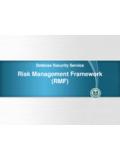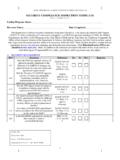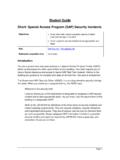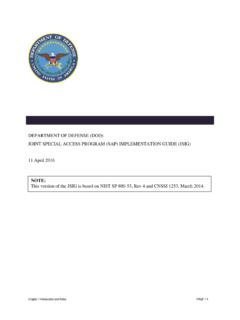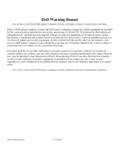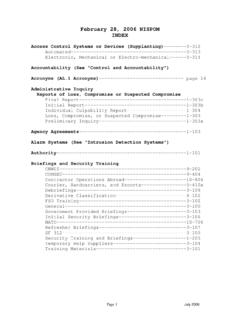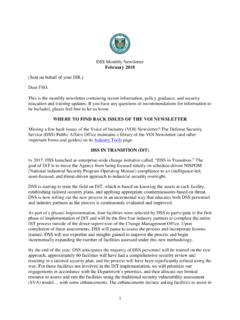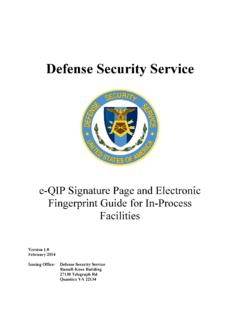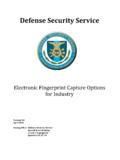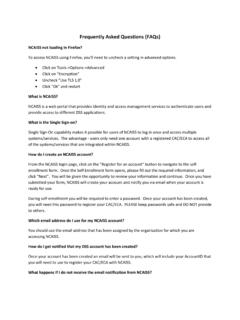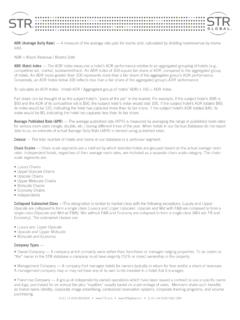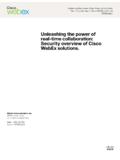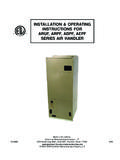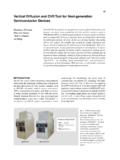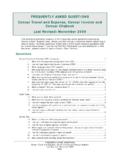Transcription of Student Guide Short: Classified Storage Requirements
1 Classified Storage Requirements Page 1 Student Guide short : Classified Storage Requirements Objective Identify appropriate Storage Requirements for different types and levels of Classified information POC Estimated completion time 25 minutes 1. Introduction As a security professional working in the DoD, you should be intimately familiar with the Requirements and best practices for storing Classified material. Chances are, you handle it on a daily basis. For that matter, you may even be a go-to resource on protecting Classified material. But do you know everything you need to know? Do you know all the options available for storing various types of sensitive and Classified material?
2 What about the unique Requirements for different types of Storage containers? This short on Classified Storage Requirements will refresh your knowledge on appropriate methods for protecting Classified information and will give you an opportunity to practice applying that knowledge. 2. Factors to Consider When determining whether a particular container or facility is appropriate for storing Classified material, one general principle always holds true: the more sensitive the material being stored, the stricter your Storage and protection methods must be. For example, Confidential information has stricter Storage Requirements than unclassified information. Likewise, Secret information must be protected at a higher level than Confidential.
3 And Top Secret information requires even greater protection than Secret. Sometimes, additional control markings are required to identify highly sensitive Classified information that requires the highest possible levels of protection. One such type of special information is sensitive compartmented information (SCI). The range of required protection measures includes the types of Storage containers or facilities as well as other, supplemental, controls, such as guards, alarms, and electronic surveillance systems. Student Guide Classified Storage Requirements Page 2 Though the primary consideration in selecting a container or facility is the sensitivity of the information, there are several other factors that play into the real-world determination of what Storage methods are most appropriate.
4 One factor is whether there are any specific threats that would require a higher level of protection (for example, storing Classified material in enemy territory). Another factor is the nature of the material being stored. For example, Storage Requirements for weapons, large items, or heavy machinery will be different than the Requirements for printed or electronic media. Finally, the geographic location of the materials being stored plays a role. The Requirements that apply to storing materials overseas in a war zone, for example may be different than those that apply to materials stored in the United States. Let's take a closer look at the specific Storage Requirements for each type of Classified information.
5 3. Storage by Classification Level All Classified material must be stored in a secure room, a GSA-approved Storage container, such as a cabinet or safe or a vault or modular vault, or a sensitive compartmented information facility (SCIF). Each of these containers and facilities will be described in more detail later in this short , but for now, we're going to start by looking at how they are used to store the types of Classified material shown here. Remember: the more sensitive the information being stored, or the higher the level of classification, the more stringent the Storage Requirements must be. Therefore, the minimum Storage Requirements are different for each level of Classified information.
6 In some situations, a secure room or GSA-approved container is enough on its own to protect Classified material. However, in other situations, additional controls are necessary to further safeguard the container or facility. These additional controls, known as "supplemental controls," will be described in more detail later. For now, you simply need to know that they are required for storing some levels of Classified material. a. Confidential Confidential material may be stored in a secure room, a cabinet or safe, or a vault or modular vault. Confidential information may also be stored in a SCIF. No additional protection is required to store Confidential material in any of these containers or facilities.
7 B. Secret Secret material may also be stored in a secure room, a cabinet or safe, a vault or modular vault, or a SCIF. However, if Secret material is stored in a secure room, Student Guide Classified Storage Requirements Page 3 then supplemental controls are required to ensure its protection. We'll look later at the specific supplemental controls required for Secret material. c. Top Secret Like the lower levels of Classified material, Top Secret material may also be stored in a secure room, a cabinet or safe, a vault or modular vault, or a SCIF. However, regardless of whether it is stored in a secure room, a cabinet or safe, or a vault, Top Secret material always requires supplemental controls.
8 We'll look later at the specific supplemental controls required for Top Secret material. d. Sensitive Compartmented Information (SCI) There is only one acceptable place to store SCI, and that is in a SCIF. Although any type of Classified material may also be stored in a SCIF, SCI may NOT be stored in anything other than a SCIF. 4. Containers and Facilities Storage containers and facilities are the physical spaces that are used to house valuable, sensitive, and Classified information and material to protect it against unauthorized disclosure. Storage containers, such as secure rooms, GSA-approved security containers, and GSA-approved vaults, are generally designed to protect Classified information and smaller sensitive items such as small weapons.
9 Storage facilities, on the other hand, are restricted areas designed to protect certain types of Classified material or for the bulk Storage of items that require larger spaces, such as missiles and other high-tech equipment. A SCIF, which is the most secure type of Storage discussed in this short , is one type of Storage facility. Whereas all Classified Storage facilities, such as SCIFs, are built to specific standards that authorize them to store specific types of information, the only Storage containers that are authorized to store Classified information are secure rooms, which must meet specific construction standards defined by the DoD, and GSA-approved security containers and vaults, which must meet strict construction standards defined by the General Services Administration (GSA).
10 A GSA-approved container is any container that has been certified as meeting a certain minimum security standard for protection of Classified information. The physical construction standards vary by type of container, but the important thing for you to know is that any container that is certified as a GSA-approved container is approved to store Classified information. Student Guide Classified Storage Requirements Page 4 GSA The General Services Administration (GSA) establishes and publishes minimum standards, specifications, and supply schedules for containers, vault doors, modular vaults, and other associated security devices suitable for the Storage and protection of Classified information against forced, covert, and surreptitious entry.
